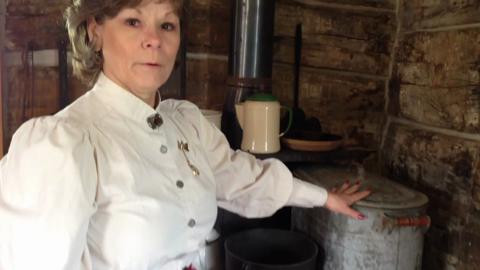Hardship was a defining characteristic of early life on the Great Plains. Pioneer Lane, a historical village nestled within the W.H. Lyon Fairgrounds, offers a vivid glimpse into the challenging lives endured by settlers in the late 1800s. Organizers emphasize that Pioneer Lane is more than just a collection of old buildings; it’s a vital link to our heritage, providing valuable insights into our past and ourselves.
For 46 years, the dedicated nonprofit Minnehaha Century Club and its passionate nine-member board have tirelessly worked to establish and maintain Pioneer Lane. Their singular mission is to preserve history, ensuring its lessons are passed down to future generations. Maintenance, repairs, ongoing upkeep, and engaging historical reenactments are primarily managed by the board and a committed group of volunteers, according to board member Ron Robinson of Sioux Falls. “Our motto is ‘History for the Fun of It,'” Robinson explains. “It’s crucial for kids to learn about our past – it’s incredibly important.”
Exploring the past is an integral part of the elementary school social studies curriculum. Harriett Wendt, who organizes tours for elementary students to this frontier village, notes, “Third-grade students specifically study pioneer life. Pioneer Lane provides them with a tangible understanding of what life was like over a century ago.”

Image alt text: Historical reenactors in period clothing demonstrate 1800s pioneer life at Pioneer Lane’s Fersdahl Cabin during an educational event at W.H. Lyon Fairgrounds, Sioux Falls.
The dedication of the volunteers is the backbone of Pioneer Lane. For decades, their primary focus has been the diligent upkeep of the historical buildings situated on the north side of the fairgrounds. Volunteers contribute their skills and time based on available resources, both in terms of manpower and funding. When necessary, professionals are hired for specialized tasks, and the dream of expanding Pioneer Lane into an even more comprehensive historical village remains a driving force.
A Glimpse into School Days of Yesteryear
History holds a personal connection for Celia Benson of Sioux Falls. “I myself attended a one-room schoolhouse in Minnehaha County,” she shares. Driven by her passion for preservation, she authored “Rural Schools of Minnehaha County 1871-1971,” a comprehensive collection documenting the history of 144 one-room schoolhouses in the region. Adding to the personal connection, one of these early schools was named after her great-grandfather, who served on the school board.
“My motivation was to ensure my granddaughter learned about the schools her ancestors attended,” Benson explains. Demonstrating her commitment, Benson generously donated the proceeds from her book sales – exceeding $20,000 – to support the restoration of the Grinde School at Pioneer Lane.
The Grinde School, a quintessential one-room schoolhouse, was originally constructed in 1885 and served the Colton area until 1947. It was relocated to Pioneer Lane in 1968 and now stands as a centerpiece of the village, where visitors can examine authentic samples of schoolwork from a bygone era.
Standing within the Grinde School, Benson vividly describes the learning environment of a one-room schoolhouse, where approximately 20 students across various grades shared desks and learned together. She points out the ink well, the chalkboard, and the gas lamps, highlighting the stark contrasts to modern educational facilities. The absence of playground equipment further underscores the differences between education then and now.
“Rural schools were frequently named after the family with the largest number of children enrolled,” Benson notes, adding a charming detail about the community-centric nature of these schools. As a historical reenactor, Benson embodies the school marm, donning period attire including boots, a long skirt, a peasant blouse, and a belt. She is one of several dedicated volunteers who dress in period clothing to bring the early way of life to life for students during late-spring field trips and visitors during the Sioux Empire Fair.
Benson engages visitors with stories of the past, describing the clothing worn by boys and girls and illustrating the evolution of educational tools. “They initially used individual slates, which evolved into large blackboards. Today, we have whiteboards and Smart Boards,” she explains. She also emphasizes the resourcefulness required in early schools, highlighting the scarcity of paper and books.
“Parents were responsible for purchasing books for their children,” Benson says, explaining that these books were treasured possessions, often passed down through families. Water conservation was another critical aspect of daily school life. “They had to carry water and use it sparingly – just 3 gallons for the entire day for 20 students,” she elaborates. Sanitation practices were also different, with some schools having separate outdoor toilets for boys and girls, while others shared a simpler outhouse.
The relationship between students and teachers was uniquely close, “because the teacher was typically boarded by local families,” Benson explains. This arrangement fostered a personal connection and integrated the teacher into the community fabric.
“It’s valuable for society to understand the evolution of education,” Benson concludes. “Reflecting on how far we’ve come in 135 years is truly remarkable.” An era in education concluded when the last one-room schoolhouse in the region closed its doors in 1971.
Exploring Other Historical Buildings at Pioneer Lane
The Fersdahl Cabin, constructed in 1868, holds a special place in local history as the birthplace of Berthine Thomas Fersdahl, the first white baby born in South Dakota. Originally located in the Renner area and donated by the Fersdahl family in 1970, the cabin has been lovingly refurbished to preserve its historical integrity.
At the log cabin, historical reenactor Jeanne Pattison shares demonstrations of pioneer skills, such as churning butter, using an old-time stove, and playing horseshoes. “Life was harder then, but in some ways, simpler,” Pattison reflects, expressing a sentiment that many visitors find resonates with them.
“There were no TVs, radios, phones, running water, or central air. They created their own entertainment,” says Pattison, a Sioux Falls resident who is passionate about historical reenactment. She appreciates the slower pace of life in the past. “I enjoy history and sharing stories about people, explaining what life was like,” she says. “It’s rewarding to see people’s reactions. It’s not just for children; adults often recall how difficult things were and appreciate the ease of modern life.”

Image alt text: Reenactors Jeanne and Bill Pattison inside the historic Fersdahl Cabin at Pioneer Lane, W.H. Lyon Fairgrounds, showcasing the living conditions of 19th-century settlers.
Also located within Pioneer Lane is the Rutland Depot, dating back to 1906. This depot was part of the original railroad line connecting Sioux Falls to Watertown, highlighting the crucial role of railroads in the development of the region.
The Good Samaritan Church, built in 1878 and originally from the Parker area, was donated to Pioneer Lane in 1971. Its presence underscores the significant role of religion in pioneer communities, as Robinson points out.
Recent additions to Pioneer Lane include a gazebo, constructed last fall, and a bandstand, a generous gift from Nyberg’s Ace. The bandstand is envisioned as a venue for brass bands and traditional music performances during the Sioux Empire Fair and throughout the year, adding to the village’s vibrant atmosphere.
The long-term vision for Pioneer Lane is ambitious: to expand it into a truly immersive living history village complete with a general store and a schedule of year-round events, according to Benson. The underlying belief is that learning about the past is essential for shaping a better future.
“Our goal is to maintain the buildings in excellent condition, expand the village’s offerings, and raise public awareness to encourage more people to visit and utilize Pioneer Lane,” Benson states. “We aspire to create a dynamic, living history village that truly brings the past to life.”
Visit Pioneer Lane
Pioneer Lane is located on the north side of the W.H. Lyon Fairgrounds and currently features four historical buildings:
- Grinde School: A one-room schoolhouse built in 1885, serving the Colton area until 1947, and relocated to Pioneer Lane in 1968.
- Fersdahl Cabin: A maple log cabin constructed in 1868 in the Renner area, the birthplace of South Dakota’s first white baby, moved to Pioneer Lane in 1970 and slated for summer repairs.
- Rutland Depot: Built in 1906 as part of the Sioux Falls-Watertown railroad line, added to Pioneer Lane in 1970.
- Good Samaritan Church: Built in 1878 in Parker, donated in 1971. The Minnehaha Century Fund undertook early restoration projects including reroofing and interior repairs.
- New additions: A gazebo and a bandstand enhance the visitor experience.
Get Involved with the Minnehaha Century Club
If you are interested in volunteering with maintenance, providing financial support, or participating in historical reenactments, please contact Ron Robinson at 334-0869.
Connect with us on Facebook and Twitter.

